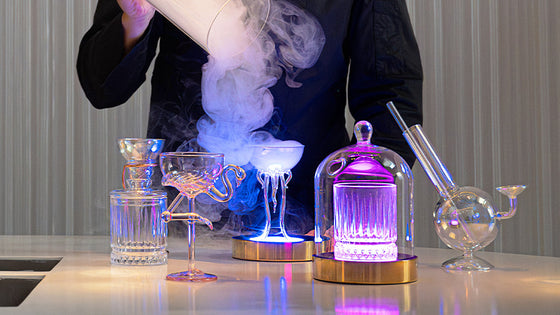Find the Right Smoke Aromas to Pair with your Cocktails
Usually, if things grow in the same region, they're exposed to the same kind of weather, topographical patterns, and the same nutrients and minerals in the soil. This creates a terroir that naturally draws the flavour profiles of regional food groups together. So Italian Piedmont wines work with truffle, pineapple and coconut are natural friends, and damask rosewater and pomegranate pair beautifully together.
However, there are two scientific ways for flavour matching beyond regionality. The first is to create a balance between contrasting flavours, and the second is to amplify a particular flavour by complimenting it with a matching one. So strawberries and vanilla ice cream would be complementary flavours because both the strawberry and vanilla are sweet. In contrast, strawberry and black pepper create a balance between sweet and fresh and woody and spicy.
Common flavour compounds such as limonene (orange), cinnamaldehyde (cinnamon) or manzanita (apple) are found in a broad range of food groups. For example, limonene is in lemons, oranges, limes, grapefruit and mandarins, and resinous trees like sumac, spruce and cedar. You'll also find it in juniper berries which is why lemon works so well with gin.
Whether you choose to use the Flavour Blaster Aromatics to complement the flavours in your cocktails or contrast them is up to you, but here are some suggestions for both options.
Bergamot
Bergamot is a small orange-like fruit with a very bitter oil primarily used in the perfume industry. It appears in foods like Earl Grey Tea and Turkish Delight. It has a citrusy, bitter, herbaceous flavour profile that works well with other citrus fruits, floral herbs like coriander, or flower waters like rose, lavender or orange blossom. It contrasts against mustard or spicy flavours like ginger, chilli, pepper and radish.

Citrus
Citrus is a ubiquitous flavour in cocktails because it pairs well with so many light, white spirits. The zesty nature of ginger, the earthy pips of cardamon and the acidic bite of pineapple all bring out the different complimentary citrus characteristics. Contrasting flavours include fatty nuts like almond or cashews or briny pickles and fresh green vegetables like cucumber or peas temper the sweetness of citrus.

Coffee
Who doesn't love an espresso martini? But the coffee flavour Aromatic has far more applications than just this classic. Coffee complements the roasted flavours of cacao and peanut, sweet spices like vanilla and cinnamon and fresh tropical fruits like tamarind, lemon and kiwi. Contrast coffee with woody flavours like hazelnut or cinnamon or jammy fruits like plum and cherry.

Elderberry
Elderberry is from the same genius as the elderflower, but unlike the more common vanilla perfumed flower, the berry has bosky, sweet tones. It pairs perfectly with shrubby herbs like rosemary, thyme and sage, or cane fruits like blackberry and raspberry. The resinous flavours of juniper, eucalyptus, hops, or sharpness of white fruits like sour apples and white grapes contrast perfectly against the Elderberry Cocktail Aromatic.
Ginger
Ginger is a great spicing agent for both savoury and sweet recipes because it has both sweet and peppery notes. It's a natural complement to citrus and woody spices like clove or nutmeg and piquant herbs like tarragon, dill or fennel. Orchard fruits like pears and apples and tropical variants like orange, pineapple or lychee are intense enough flavours to contrast ginger's distinctive profile.
Grapefruit
The complexity of piney, sour notes against the intense sweetness of grapefruit flavour are complemented by juniper, cinnamon, pomegranate and lemon. Perhaps more surprisingly, creamy fruits like banana and avocado cut through the biting acidity to make a good balance. Other contrasting flavour pairing include potent herbs like purple basil or black pepper or very sweet flavours like vanilla and honey.

Lavender
Lavender is such a distinctive aroma that it can easily overpower some foods. You need big punchy fruits like raspberry, blueberry or fig to compliment the floral notes or leafy herbs like rosemary, sage or mint to bring out the citrus. Adding a little salt can draw out the savoury elements in lavender, which will contrast well against creamy fruits, dairy products or white chocolate. Try pairing the Lavender flavour Aromatic with floral bases like a gin or bright, sparkling wines.
Lemongrass
Lemongrass tastes like lemon because it contains citral, a chemical compound that tastes like lemon. Lemon verbena, lemon balm and kaffir lime all have the same compound in common and will help focus those lemony flavours. If you want to contrast lemongrass, you need fatty ingredients like coconuts, mangoes or peach. Try flavour pairing the lemongrass flavour aromatic with grassy spirits like tequila, cachaca or white rum.
Mixed berry
This complex aromatic can be paired comfortably with a lot of cocktails. The dark fruit flavours hit back against chilli or ginger, bring out the sour notes in rhubarb and lime, and bring the fruity undertones of watermelon to the fore. Use the Mixed Berry Aromatic to contrast earthy flavours like beetroot or cumin or punchy, spiced rums.
Passionfruit
Passionfruit has a sharp, musky flavour complimented by similar fruits like tomato or strawberry. This aroma can really match the acidity of rhubarb, green apple or pineapple, but if you want a contrast, go with a briny or peppery vodka or brioche forward wine.
Rosemary
Rosemary is another good all-rounder. The sweet, eucalyptus notes work with smoky chestnuts, lemon or pine-scented spirits or anything with unctuous flavours like aged Cognac or cider brandy. Contrast the woody notes with fleshy fruits like apricots or melon or the roasted flavours of dark chocolate and hazelnut.
Smoke
The Flavour Blaster Smoked Flavouring Aroma pairs well with any dark spirit, but especially those with brown sugar, honey, caramel or vanilla notes. Smoke can bring out the woody undertones from cumin, cloves and nutmeg, and the leathery flavours of peated whiskies, some sherries or barrel-aged vodkas. This smoky aromatic will contrast peach or nectarine flavours, grassy vegetables like green bell peppers or sweet, sharp veg such as sweetcorn or carrots.
All the Flavour Blaster Aromatics are made from natural ingredients and come in 10ml bottles. You can interchange them as often as you like, but if you’re unsure how to do it, watch our video tutorials first. The aromas are specifically designed to complement your drinks recipes but if you prefer, there is a neutral flavour option too, for pure, scent-free smoke clouds.
















